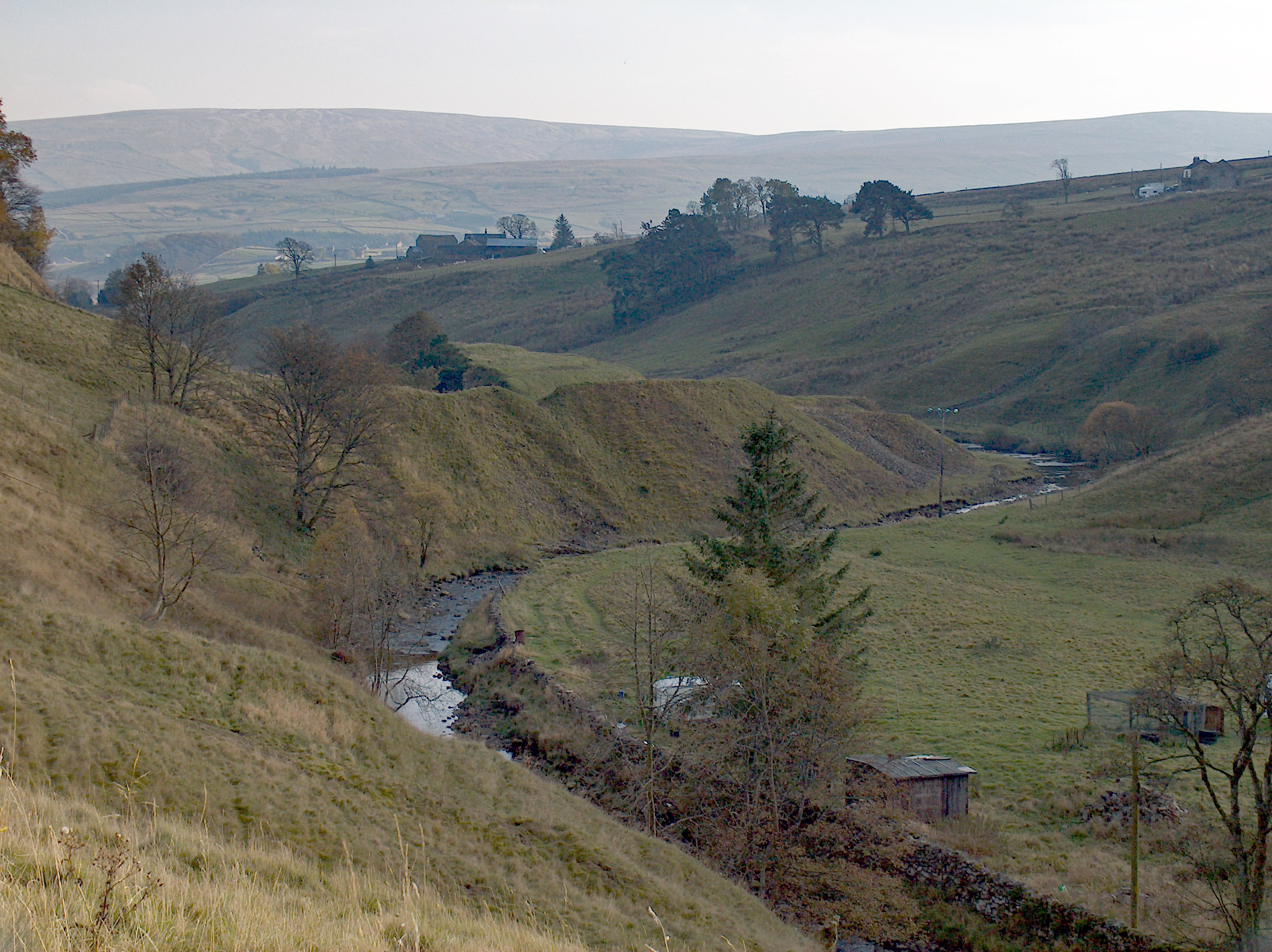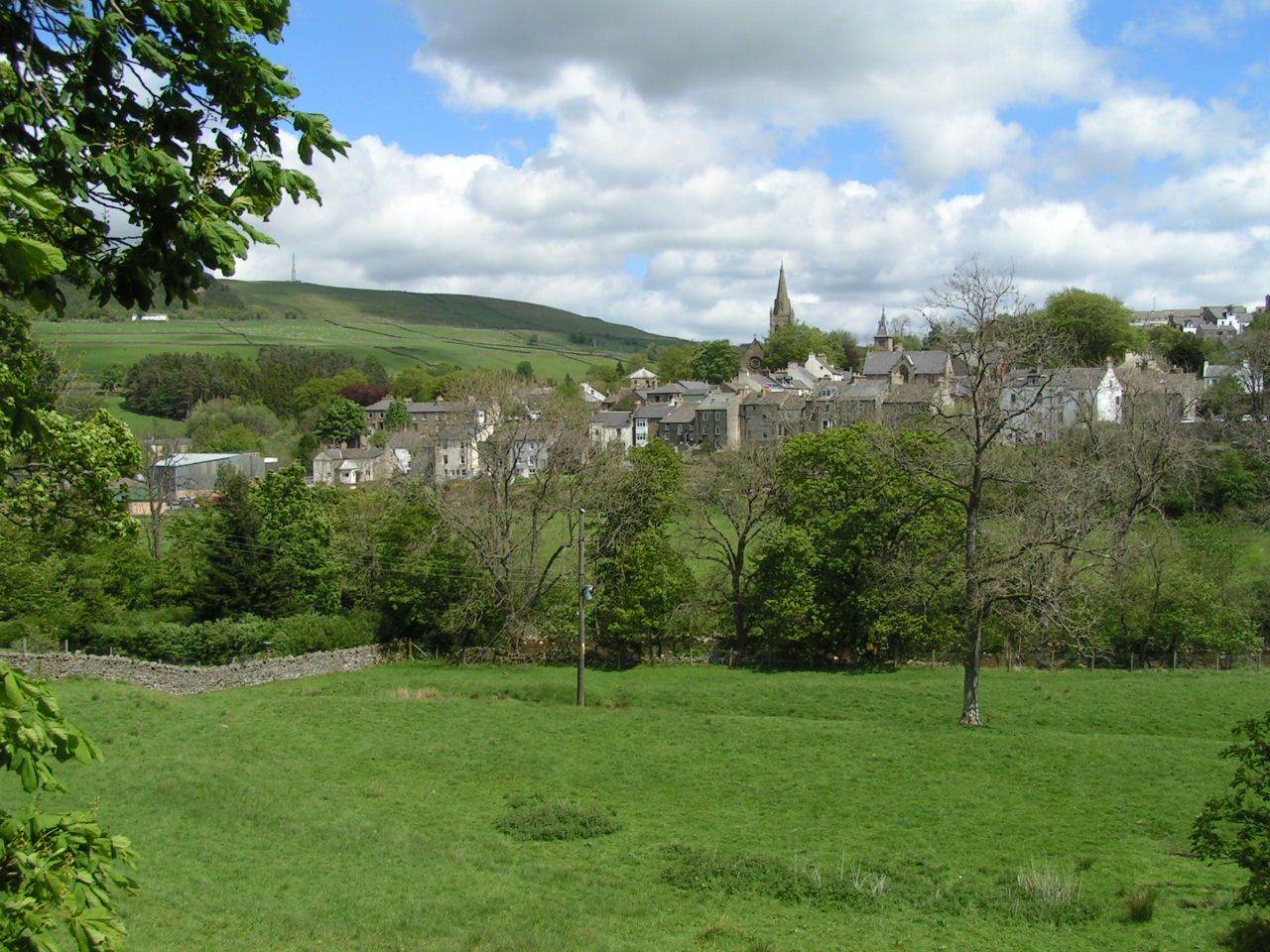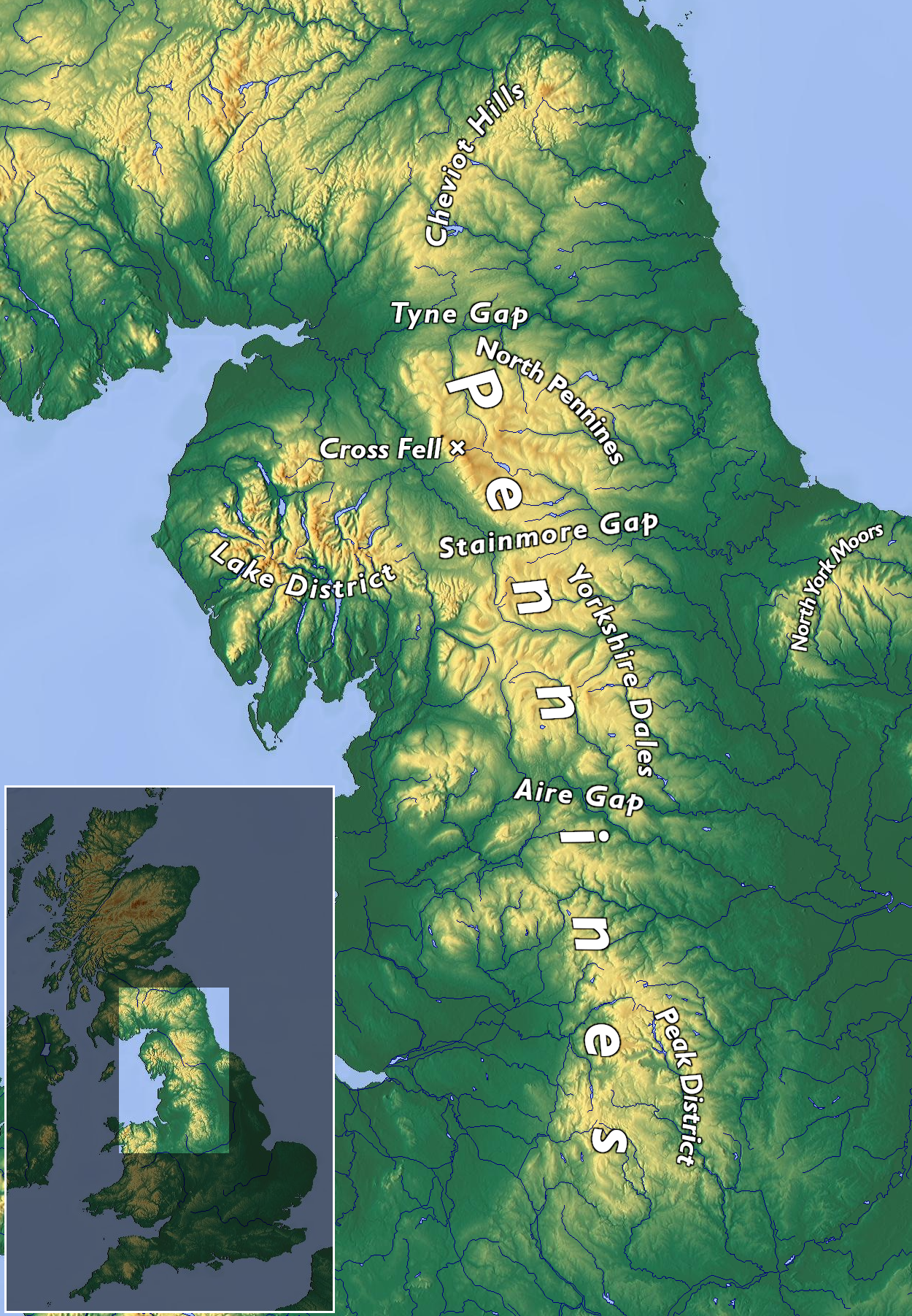|
Burnhope Seat
Burnhope Seat is a high moorland fell in the North Pennines Area of Outstanding Natural Beauty (AONB) in northern England. It lies between the heads of the Rivers Tees, South Tyne and Wear. The summit is crossed by the boundary between County Durham and Cumbria (historically Cumberland). The trig point is the highest point in historic County Durham. However, this is not quite the summit of the mountain (which lies 400 m west and 1 m higher across the border into historic Cumberland). Mickle Fell, south of Teesdale is higher than Burnhope Seat and is sometimes quoted as being the highest top of County Durham, but this is historically not correct. Mickle Fell, although it lies within the unitary council area of Durham County Council for administrative purposes, is historically a part of the North Riding of Yorkshire, and is the highest point in that county. The character of the fell is very typical of the high Pennines, with an extensive and poorly drained summit plateau ... [...More Info...] [...Related Items...] OR: [Wikipedia] [Google] [Baidu] |
Cross Fell
Cross Fell is the highest mountain in the Pennines of Northern England and the highest point in England outside the Lake District. It is located in the North Pennines Area of Outstanding Natural Beauty. It lies within the county of Cumbria and the historic county boundaries of Cumberland. The summit, at , is a stony plateau, part of a ridge running north-west to south-east, which also incorporates Little Dun Fell at and Great Dun Fell at . The three adjoining fells form an escarpment that rises steeply above the Eden Valley on its south-western side and drops off more gently on its north-eastern side towards the South Tyne and Tees Valleys. Cross Fell summit is crowned by a cross-shaped dry-stone shelter. On a clear day there are excellent views from the summit across the Eden Valley to the mountains of the Lake District. On the northern side of Cross Fell there are also fine views across the Solway Firth to the Southern Uplands of Scotland. The fell is prone to dense hil ... [...More Info...] [...Related Items...] OR: [Wikipedia] [Google] [Baidu] |
Historic Counties Of England
The historic counties of England are areas that were established for administration by the Normans, in many cases based on earlier Heptarchy, kingdoms and shires created by the Angles, Saxons, Jutes, Celts and others. They are alternatively known as ancient counties, traditional counties, former counties or simply as counties. In the centuries that followed their establishment, as well as their administrative function, the counties also helped define local culture and identity. This role continued even after the counties ceased to be used for administration after the creation of Administrative counties of England, administrative counties in 1889, which were themselves amended by further local government reforms in the years following. Unlike the partly self-governing Ancient borough, boroughs that covered urban areas, the counties of medieval England existed primarily as a means of enforcing central government power, enabling monarchs to exercise control over local areas throug ... [...More Info...] [...Related Items...] OR: [Wikipedia] [Google] [Baidu] |
Skiing
Skiing is the use of skis to glide on snow. Variations of purpose include basic transport, a recreational activity, or a competitive winter sport. Many types of competitive skiing events are recognized by the International Olympic Committee (IOC), and the International Ski Federation (FIS). History Skiing has a history of almost five millennia. Although modern skiing has evolved from beginnings in Scandinavia, it may have been practiced more than 100 centuries ago in what is now China, according to an interpretation of ancient paintings. However, this continues to be debated. The word "ski" comes from the Old Norse word "skíð" which means to "split piece of wood or firewood". Asymmetrical skis were used in northern Finland and Sweden until at least the late 19th century. On one foot, the skier wore a long straight non-arching ski for sliding, and a shorter ski was worn on the other foot for kicking. The underside of the short ski was either plain or covered with animal ... [...More Info...] [...Related Items...] OR: [Wikipedia] [Google] [Baidu] |
Burnhope Reservoir
Burnhope Reservoir ( ) is a reservoir above the village of Wearhead, County Durham, England. The reservoir was created by the construction of an earth embankment dam across the valley of Burnhope Burn, a tributary of the River Wear, above Wearhead. Construction of the dam began in 1931 and was completed in 1937; an extensive network of narrow gauge railways, the Burnhope Reservoir railway, was used during the construction of the dam. Filling of the reservoir commenced in 1936 and resulted in the drowning of the former village of Burnhope. Burnhope Reservoir was a joint project of the Durham County Water Board and the Sunderland and South Shields Water Company. It is now owned and operated by Northumbrian Water. The reservoir supplies water to the Wear Valley treatment works at Wearhead and there is a pipeline connection to Waskerley Reservoir, which supplies Honey Hill water treatment works. The reservoir serves as the source to meet regulated discharges into the River We ... [...More Info...] [...Related Items...] OR: [Wikipedia] [Google] [Baidu] |
Weardale
Weardale is a dale, or valley, on the east side of the Pennines in County Durham, England. Large parts of Weardale fall within the North Pennines Area of Outstanding Natural Beauty (AONB) – the second-largest AONB in England and Wales. The upper dale is surrounded by high fells (up to O.D. at Burnhope Seat) and heather grouse moors. The River Wear flows through Weardale before reaching Bishop Auckland and then Durham, meeting the sea at Sunderland. The Wear Valley local government district covered the upper part of the dale, including Weardale, between 1974 and 2009, when it was abolished on County Durham's becoming a unitary authority. (From 1894 to 1974 there was a Weardale Rural District.) Upper Weardale is in the parliamentary constituency of North West Durham. The dale's principal settlements include St John's Chapel and the towns of Crook, Stanhope and Wolsingham. Local climate Weardale's winters are typically harsh and prolonged with regular snow, nowadays ta ... [...More Info...] [...Related Items...] OR: [Wikipedia] [Google] [Baidu] |
Middleton-in-Teesdale
Middleton-in-Teesdale is a market town in County Durham (district), County Durham, in England. It is situated on the north side of Teesdale between Eggleston and Newbiggin, Teesdale, Newbiggin, a few miles to the north-west of Barnard Castle. The settlement is surrounded by the North Pennines Area of Outstanding Natural Beauty (AONB). Administration Middleton is administered by County Durham, Durham County Council. It is part of the Bishop Auckland (UK Parliament constituency), Bishop Auckland parliamentary constituency in the House of Commons. Prior to Brexit in 2020, it was a part of the North East England (European Parliament constituency), North East England constituency for the European Parliament. The local police force is Durham Constabulary. History The small market town in Upper Teesdale expanded in the early 19th century when the London Lead Company moved its northern headquarters there from Blanchland in Northumberland. Much of the architecture from its days as a com ... [...More Info...] [...Related Items...] OR: [Wikipedia] [Google] [Baidu] |
Alston, Cumbria
Alston is a town in Cumbria, England, within the civil parish of Alston Moor on the River South Tyne. It shares the title of the 'highest market town in England', at about above sea level, with Buxton, Derbyshire. Despite its altitude, the town is easily accessible via the many roads which link the town to Weardale, Teesdale, and towns in Cumbria such as Penrith via Hartside Pass, as well as Tynedale. Historically part of Cumberland, Alston lies within the North Pennines, a designated Area of Outstanding Natural Beauty. Much of the town centre is a designated Conservation Area which includes several listed buildings. Geography Alston lies within the North Pennines Area of Outstanding Natural Beauty, more than by road from the nearest town, Haltwhistle, and is surrounded by moorland. Nearby villages include Garrigill and Nenthead. It is around west of Newcastle upon Tyne, south east of Carlisle, north east of Penrith, and south west of Hexham. Situated at the crossroads/j ... [...More Info...] [...Related Items...] OR: [Wikipedia] [Google] [Baidu] |
B6277 Road
B6 often refers to: * Vitamin B6, Vitamin B6 B6 may also refer to: Transportation Automobiles * A generation of Audi A4, manufactured from 2001 to 2005 * A fully armoured version of the Bentley Arnage Series Two RL * A member of the Mazda B engine#B6, Mazda B engine series Aircraft *Blackburn Shark, Blackburn B.6 Shark, a British 1930s torpedo bomber *Keystone B-6, a United States Army Air Corps bomber *Lohner B.VI, an Austro-Hungarian World War 1 reconnaissance biplane *Bréguet 14, Nakajima B-6, Nakajima designation for Bréguet 14 built under licence in Japan *Republic 2PA, Republic B 6, Swedish designation for Republic 2PA fighter Other vehicles * B6 (New York City bus), serving Brooklyn * Bavarian B VI, an 1863 German steam locomotive model * , a submarine of the Royal Navy * , a submarine of Norway Roads * B6 road (Cyprus), a road on the island of Cyprus * B6 (Zimbabwe), a Transport in Zimbabwe, road in Zimbabwe * Bundesstraße 6, a national highway in Germany Life scie ... [...More Info...] [...Related Items...] OR: [Wikipedia] [Google] [Baidu] |
Peat Bog
A bog or bogland is a wetland that accumulates peat as a deposit of dead plant materials often mosses, typically sphagnum moss. It is one of the four main types of wetlands. Other names for bogs include mire, mosses, quagmire, and muskeg; alkaline mires are called fens. A baygall is another type of bog found in the forest of the Gulf Coast states in the United States.Watson, Geraldine Ellis (2000) ''Big Thicket Plant Ecology: An Introduction'', Third Edition (Temple Big Thicket Series #5). University of North Texas Press. Denton, Texas. 152 pp. Texas Parks and Wildlife. Ecological Mapping systems of Texas: West Gulf Coastal Plain Seepage Swamp and Baygall'. Retrieved 7 July 2020 They are often covered in heath or heather shrubs rooted in the sphagnum moss and peat. The gradual accumulation of decayed plant material in a bog functions as a carbon sink. Bogs occur where the water at the ground surface is acidic and low in nutrients. In contrast to fens, they derive most of t ... [...More Info...] [...Related Items...] OR: [Wikipedia] [Google] [Baidu] |
Tussock (grass)
Tussock grasses or bunch grasses are a group of grass species in the family Poaceae. They usually grow as singular plants in clumps, tufts, hummocks, or bunches, rather than forming a sod or lawn, in meadows, grasslands, and prairies. As perennial plants, most species live more than one season. Tussock grasses are often found as forage in pastures and ornamental grasses in gardens. Many species have long roots that may reach or more into the soil, which can aid slope stabilization, erosion control, and soil porosity for precipitation absorption. Also, their roots can reach moisture more deeply than other grasses and annual plants during seasonal or climatic droughts. The plants provide habitat and food for insects (including Lepidoptera), birds, small animals and larger herbivores, and support beneficial soil mycorrhiza. The leaves supply material, such as for basket weaving, for indigenous peoples and contemporary artists. Tussock and bunch grasses occur in almost any habitat ... [...More Info...] [...Related Items...] OR: [Wikipedia] [Google] [Baidu] |
Pennines
The Pennines (), also known as the Pennine Chain or Pennine Hills, are a range of uplands running between three regions of Northern England: North West England on the west, North East England and Yorkshire and the Humber on the east. Commonly described as the "backbone of England", the range stretches northwards from the Peak District at the southern end, through the South Pennines, Yorkshire Dales and North Pennines to the Tyne Gap, which separates the range from the Border Moors and Cheviot Hills across the Anglo-Scottish border, although some definitions include them. South of the Aire Gap is a western spur into east Lancashire, comprising the Rossendale Fells, West Pennine Moors and the Bowland Fells in North Lancashire. The Howgill Fells and Orton Fells in Cumbria are sometimes considered to be Pennine spurs to the west of the range. The Pennines are an important water catchment area with numerous reservoirs in the head streams of the river valleys. The North Pennin ... [...More Info...] [...Related Items...] OR: [Wikipedia] [Google] [Baidu] |
North Riding Of Yorkshire
The North Riding of Yorkshire is a subdivision of Yorkshire, England, alongside York, the East Riding and West Riding. The riding's highest point is at Mickle Fell with 2,585 ft (788 metres). From the Restoration it was used as a lieutenancy area, having been previously part of the Yorkshire lieutenancy. Each riding was treated as a county for many purposes, such as quarter sessions. An administrative county, based on the riding, was created with a county council in 1889 under the Local Government Act 1888. In 1974 both the administrative county and the North Riding of Yorkshire lieutenancy were abolished, replaced in most of the riding by the non-metropolitan county and lieutenancy of North Yorkshire. History Archives from 1808 record that the "north-riding of York-shire" had once consisted of "fifty-one lordships" owned by Robert the Bruce. During the English Civil War, the North Riding predominantly supported the royalist cause, while other areas of York ... [...More Info...] [...Related Items...] OR: [Wikipedia] [Google] [Baidu] |







